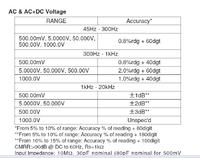Hello.
I think the thread has already been here, but I can't find it.
For about a month, I have been noticing the dimming of lamps, microwave fans, LED lighting, etc.
Today I decided to take measurements with the Sanwa PC5000a meter - I think it is sufficient for reliable measurements.
Finally, I measured 3 phases just at the output of the meter in the main distribution box and it turned out that at the time of measuring the voltage they were respectively 200, 215 and 215v
My question is, is this acceptable?
Because an employee at 911 said that 10-15% is acceptable, which means that this fluctuation would be within the norm.
I would like to add that the whole problem began when the construction of a large housing estate was completed several meters away.
I have heard that they have to put up a transformer and so far they cannot connect the housing estate (they cannot connect it to the main street line, but they have to draw electricity from another ...
But I see that some residents somehow have electricity in their apartments.
Recently, I have lost quite expensive electronic equipment and I wonder if it is not for this ...
I will be grateful for your advice.
Best regards.
I think the thread has already been here, but I can't find it.
For about a month, I have been noticing the dimming of lamps, microwave fans, LED lighting, etc.
Today I decided to take measurements with the Sanwa PC5000a meter - I think it is sufficient for reliable measurements.
Finally, I measured 3 phases just at the output of the meter in the main distribution box and it turned out that at the time of measuring the voltage they were respectively 200, 215 and 215v
My question is, is this acceptable?
Because an employee at 911 said that 10-15% is acceptable, which means that this fluctuation would be within the norm.
I would like to add that the whole problem began when the construction of a large housing estate was completed several meters away.
I have heard that they have to put up a transformer and so far they cannot connect the housing estate (they cannot connect it to the main street line, but they have to draw electricity from another ...
But I see that some residents somehow have electricity in their apartments.
Recently, I have lost quite expensive electronic equipment and I wonder if it is not for this ...
I will be grateful for your advice.
Best regards.




